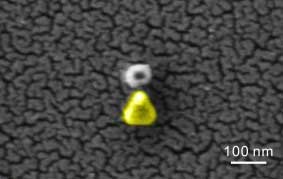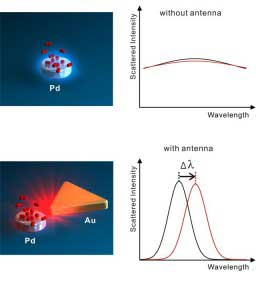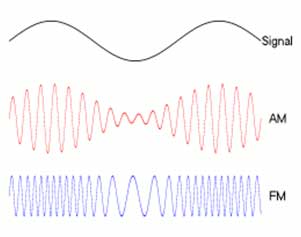Nanoantennas – detecting the very small
How many ways can you think of to detect a single particle or atom? What uses would a tool that could do this have? The nanoantenna can! Read on to find out how and what uses it might have.1-3
About Antennas
An antenna is a device used to propagate, receive, and/or transmit electromagnetic waves which can have information embedded within them. Most people think of radio waves when they think of antennas. Radio waves are just one type of electromagnetic wave. For example, a sound wave may be translated into an electronic signal that is sent to a transmitter (antenna). The antenna creates an electromagnetic wave that carries the original embedded sound information through the atmosphere/space around it. An antenna at a different location, receives the electromagnetic wave, sending it to circuitry (your radio) that then translates it to an electronic signal and then back to a sound wave.
Radio waves are used for wireless transmissions (such as from cell phone towers to the cell phone and wireless internet connections). The radio wave is created by an accelerated charge. This can be done using an alternating current circuit, which forces the electrons in the electrically conducting antenna (a transmitter or receiver) to move back and forth along the antenna. As they move back and forth they speed up and slow down and create an electromagnetic wave. The way in which they oscillate carries the embedded information. For example, the signal can have information carried on it by adjusting or modulating the frequency of the wave. To do this, one alters how many times the oscillations occur per second. This is known as a frequency modulated wave or FM. Another way to embed information on a wave is to modulate the amplitude of the wave. To do this, one adjusts how far the oscillation goes back and forth. This is called amplitude modulation or AM. Try creating a radio signal yourself with this fun computer simulation.
One of the important requirements of an antenna is that the antenna’s length be related to the wavelength of the electromagnetic wave that it is trying to transmit or receive.
Nanoantennas

Palladium nanoparticle above a gold nanoantenna.
Image courtesy of Alivisatos group.2,3
Nano means one billionth. A nanoantenna is an antenna that is very, very small, and is not used to carry our embedded sound waves from one place to another. It is used to gain understanding about what is happening on an atomic scale. An image of a gold nanoantenna created by the Paul Alivisatos group at Lawrence Berkley National Laboratory, along with researchers at the University of Stuttgart in Germany, is shown below. Above the gold nanoantenna is a palladium nanoparticle. The purpose of their research is to figure out a way to measure interactions on the atomic scale so that an extremely sensitive gas sensor – one that might be able to detect a single particle – may be created. The optical properties of palladium are altered when hydrogen atoms are nearby and this should be detectable, but the effect is so small that it is hard to measure. Measuring the presence of hydrogen gas with more commonly used techniques can be dangerous because hydrogen is very explosive.
Hydrogen can be absorbed into palladium. The hydrogen atoms situate themselves between the palladium atoms rather easily. When the hydrogen atoms sit between the palladium atoms in this way the substance is called palladium hydride. The hydrogen atoms can also easily leave the palladium. Each time hydrogen enters or leaves the palladium structure, a change in how the palladium nanoparticle interacts with electromagnetic waves occurs.

Scattered intensity of light from a palladium. Image courtesy of Alivisatos group.2,3
Researchers measured how an incoming electromagnetic wave in the visible region was scattered off of the palladium nanoparticle. Each time hydrogen atoms were absorbed or released from the palladium the light scattered in a different way, however the measurements were not so obvious, as shown in the first image below. Researchers tried to enhance the signal to improve their measurements. A gold antenna, of just the right dimensions to make it resonant with the electromagnetic waves involved, was brought nearby. The antenna’s sharp tip is strongly affected by the scattered electromagnetic waves causing an oscillation of the electrons within the gold antenna tip that travels down the antenna. The detected signal is increased, becoming very clear as shown below, and this is music to any researcher’s ear.
References and Links
1. Dumé, Belle, Nanoantennas target single particles, Physicsworld.com, American Institute of Physics, 26 May 2011.
2. Liu, N., Tang, M., Hentschel, M. Giessen, H., & Alivisatos, A.P., Nanoantena-enhanced gas sensing in a single tailored nanofocus, Nature Materials, 15 May 2011.
3. Yarris, Lynn, Sharpening the Nanofocus: Berkely Lab Researchers Use Nanoantenna to Enhance Plasmonic Sensing, Berkley Lab News Center, 17 May 2011.
4. http://en.wikipedia.org/wiki/Amplitude_modulation
5. Brian, Marshall, How the Radio Spectrum Works
H.M. Doss















